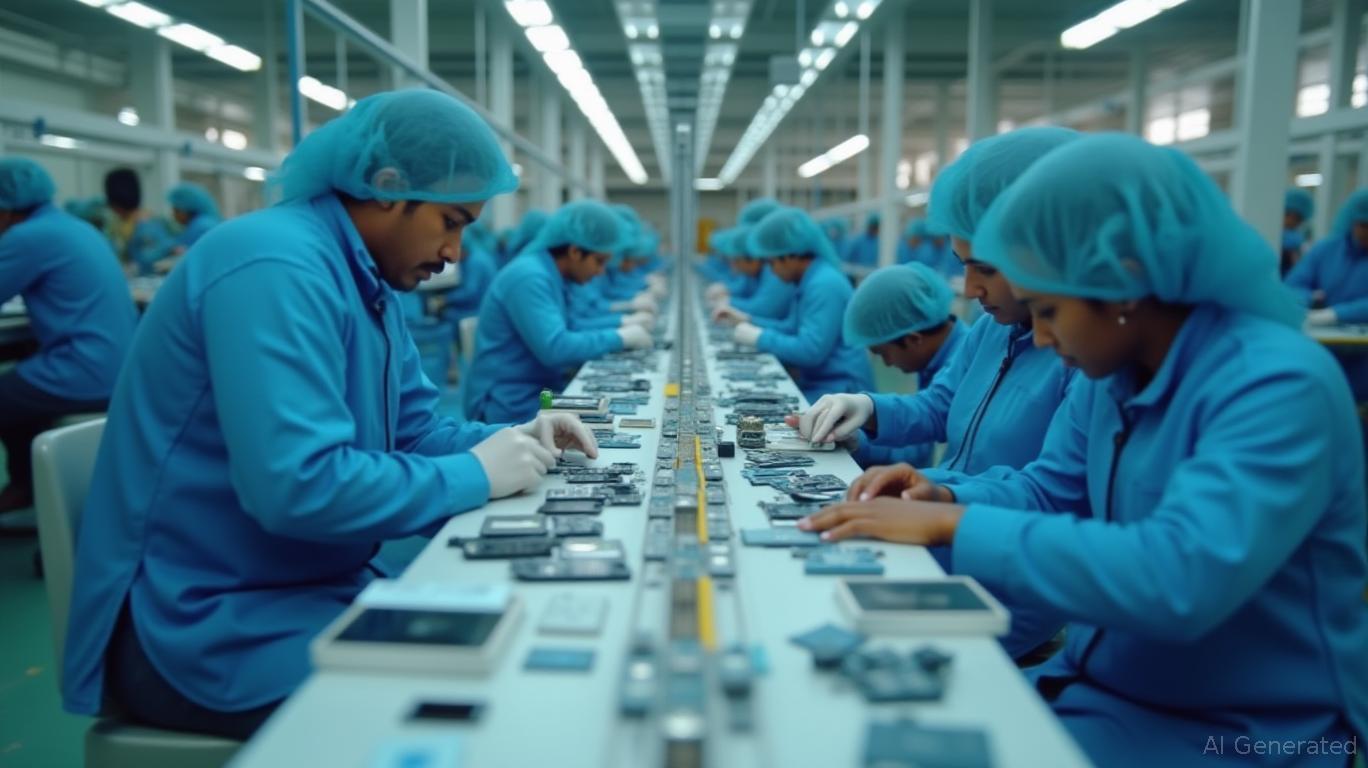Apple's Strategic Shift to India: Navigating Tariffs and Geopolitical Risks in Tech Manufacturing
The tech industry is witnessing a seismic shift as
reroutes 97% of Foxconn's Indian iPhone exports to the U.S. between March and May 2025—a stark increase from 50.3% in 2024. This move underscores a broader decoupling from China amid escalating U.S.-China trade tensions, with tariff mitigation and supply chain resilience driving tech giants to restructure global manufacturing. For investors, this trend offers opportunities in companies enabling the shift while posing risks to those tied to China-based production.
The Geopolitical Tariff Catalyst
Apple's pivot to India is a direct response to U.S. tariffs on Chinese imports, which reached as high as 55% before recent negotiations to reduce them. By producing iPhones in India, Apple avoids these levies, incurring only a 10% U.S. tariff on Indian-made units. This cost differential—compared to a projected 30% price hike for U.S.-made iPhones—highlights the financial incentive behind the shift.
Between March and May 2025, Foxconn exported $3.2 billion worth of iPhones from India, with nearly all shipments heading to the U.S. May's exports hit $1 billion, second only to March's record $1.3 billion. Year-to-date exports through May 2025 reached $4.4 billion, surpassing 2024's total of $3.7 billion. This acceleration reflects Apple's aggressive timeline to shift production, driven by Counterpoint Research's projection that Indian-made iPhones will account for 25–30% of global shipments in 2025, up from 18% in 2024.
Implications for Investors: Winners and Losers
Winners:
1. Foxconn (HNHDY) and Tata Electronics: As Apple's primary Indian manufacturers, these firms stand to benefit from the surge in U.S. exports. Foxconn's Chennai plant, now a linchpin for Apple's tariff strategy, has seen customs clearance times slashed from 30 to 6 hours—a logistical feat that could boost margins. Tata's iPhone exports to the U.S. rose to 86% in early 2025, up from 52% in 2024, signaling broader industry momentum.
India's Manufacturing Ecosystem: Companies supplying components (e.g., glass, semiconductors) to Apple's Indian partners may see demand rise. However, India's high import duties on phone components (a key cost hurdle) could pressure margins unless the government eases restrictions.
U.S. Tariff Beneficiaries: Apple (AAPL) itself gains by reducing exposure to China's tariffs, which could stabilize its 20–30% gross margins. The shift also insulates the company from geopolitical shocks, a critical factor for long-term investors.
Losers:
- China-Based Suppliers: Firms like Foxconn's competitors in China or component makers reliant on U.S.-China trade could face declining demand as Apple pivots.
- U.S. Manufacturing Hopes: President Trump's calls for domestic production clash with cost realities, making U.S.-based assembly economically unfeasible for Apple unless tariffs on Chinese goods drop further.
Investment Strategy: Positioning for the Shift
Buy Foxconn and Tata Electronics: Both are direct beneficiaries of Apple's strategy. Foxconn's stock, while volatile, could rise if its India operations scale profitably. Tata's smaller size and Apple exposure may offer higher upside.
Hold Apple for Strategic Agility: Apple's ability to pivot supply chains while maintaining demand in the U.S. (its largest market) positions it as a resilient play. Monitor its inventory levels and gross margins for execution quality.
Caution on China-Tethered Tech Stocks: Avoid overexposure to firms with heavy reliance on Chinese manufacturing unless they have clear India/U.S. diversification plans.
Logistics and Infrastructure Plays: Companies enabling faster exports (e.g., air freight providers chartered by Apple) or improving Indian infrastructure (e.g., customs digitization) could benefit indirectly.
Risks and Considerations
- India's Component Costs: High tariffs on imported parts could erode cost savings. Watch for government reforms or Apple's progress in localizing supply chains.
- U.S.-India Trade Talks: A potential 26% reciprocal tariff on Indian goods could disrupt momentum if not resolved.
- Demand Volatility: iPhone sales depend on U.S. consumer spending; a recession could test Apple's pricing flexibility.
Conclusion: A New Manufacturing Era
Apple's shift to India is not just a tactical move—it's a strategic realignment of global tech manufacturing. For investors, this signals a long-term trend toward decoupling from China's supply chain risks. Positioning in Indian manufacturers and Apple itself, while hedging against China-exposed stocks, could yield outsized returns. The next few quarters will reveal whether India can overcome its logistical and regulatory hurdles to become the manufacturing hub Apple needs—a verdict that will reshape the tech landscape for years to come.

Comments
No comments yet